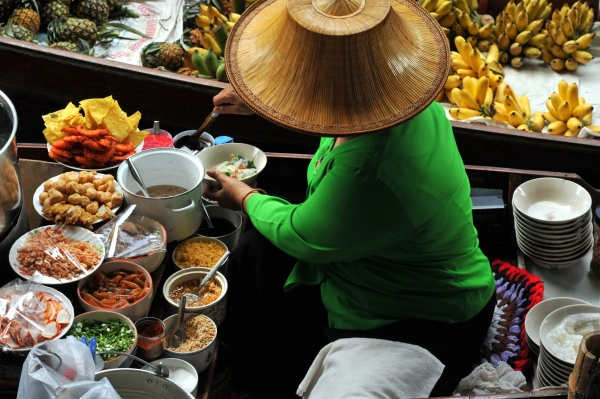12 Best Fruits to Try in Thailand – Exotic and Colourful
-- Last Updated on January 18, 2023 by Jonesy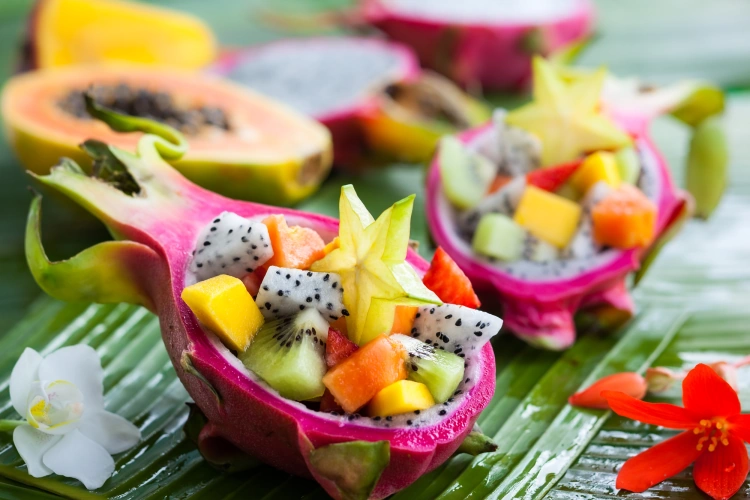
The tropical climate of Thailand ensures an abundance of exotic-looking fruit. This is obvious from the plethora of brightly-coloured wares sold even by simple street vendors that may surprise and delight first-time visitors.
The tropical climate of Thailand ensures an abundance of exotic-looking fruit. This is obvious from the plethora of brightly-coloured wares sold even by simple street vendors that may surprise and delight first-time visitors.
Many of the lesser-known Thai fruits may even seem strange—certainly they look it—and admittedly there are those among them that could be something of an acquired taste for some people. These are likely to be the ones that look, taste, or even smell a bit odd.
But thankfully one of the real bonuses that still exist on a visit to Thailand is the reasonably low cost of fruit. Thus the value for money of this particularly refreshing and healthful food item makes it easy to test lots of new delights. This can turn out to be a major positive for the more healthful-minded visitor to Thailand.
Although some of the fruit featured on this list is seasonal, it is still possible to find a lot of it year-round in Thailand, even if it is just the canned variety. So let’s have a closer look at the top 12 fruits to try in Thailand.
1. The Mystical-Looking Dragon Fruit
A top contender for possibly the most exotic-looking Thai fruit is the Dragon Fruit. So-called due to its somewhat alien-looking bright pink exterior that apparently resembles a dragon in some respects, this is a fruit that needs to be cut and taken out of the skin first.
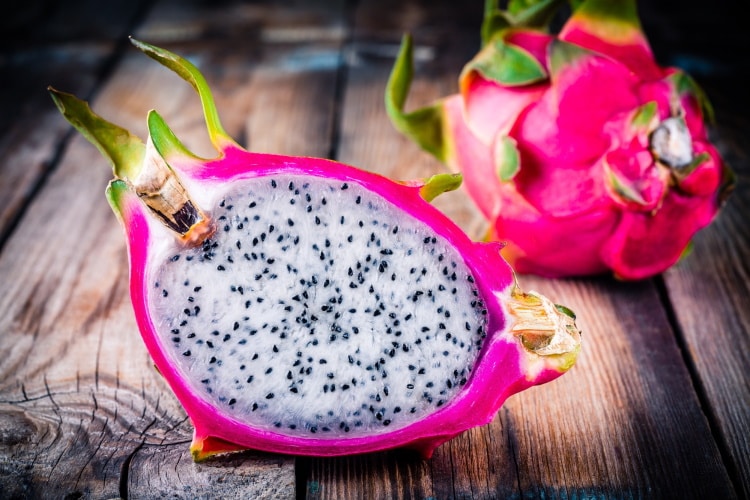
The fruit inside the exotic-looking skin is white, with tiny black seeds that are apparently good for the stomach, according to local lore. The white fruit is the most common variety although some dragon fruits contain purple flesh. There is even another slightly less-common variety that reveals a yellow or even pink interior once opened up.
The taste is sweet (although not too much) and cooling, without any citrus or sour twang, and even a small portion of dragon fruit can actually also prove quite filling. Ideal for hot days and sold as either cut fruit or by the kilo, the exotic dragon fruit is a ‘must-try’ on any trip to Thailand.
Little-known fact: not a lot of people know this but apparently the dragon fruit was introduced to SE Asia by the French in the 19th century after they had first found it in South and Central American regions where it is known as a Pitaya.
2. The Thai ‘Stinky’ Fruit—Durian
The seasonal durian is an acquired taste for both locals and visitors alike apparently. Known as Thailand’s ‘stinky’ fruit, the durian sometimes proves to be a little too exotic on occasional instances—even to the point of being prohibited in some public areas!
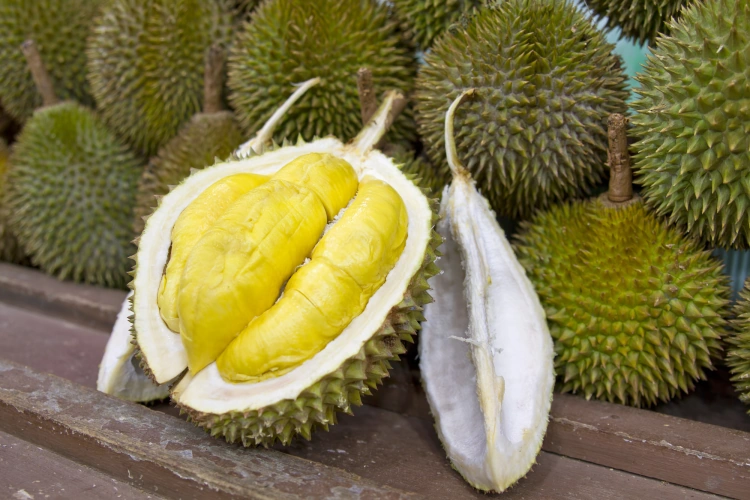
The durian certainly does have a somewhat ‘unique’ smell. This makes it easily identifiable, but the constitution and taste of this somewhat sweet, creamy, and high-calorie fruit with an almost garlic-type twang to it makes it unlike any other. For many this cements its popularity, while for others the exact opposite will be the case.
The durian’s unmistakable, alien-like exterior reveals a golden yellow cluster of fruit that gives off that unique aroma in measures according to its ripeness once cracked open.
Durian seems to be massively popular with Chinese and other Asian tourists, which has helped exports no end. As with most fruits there are a variety of reported health benefits from eating durian, mainly related to minerals like Iron, Manganese, and vitamins B and C.
Take heed though, there are various warnings that come with this bizarre fruit that the locals won’t be slow to inform you about if you indulge regularly.
The first thing to be aware of is that durian is surprisingly high in calories! Perhaps even more of an issue in health terms though is that durian is a ‘warming’ fruit, which apparently makes it unsuitable for certain groups of people like pregnant women, for instance.
3. The Super-Juicy Yellow Mango
There is a huge variety of mangoes to be found in the regions of Thailand. The yellow one is undoubtedly the most exotic though, and comes into season just before the summer hots up bigtime in April.
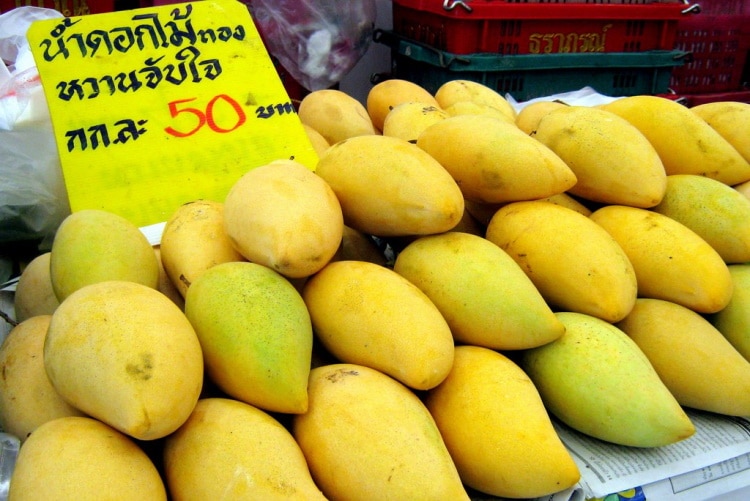
These sweet, succulent, cooling mangoes are the strain typically paired with sweet sticky rice as one of the best-known and most popular Thai desserts. The juicy Thai yellow mango is undoubtedly a summer treat not to be missed, however you eat it.
The yellow mango has usually passed the peak of availability by the beginning of June, and if you do see any yellow-looking ones around after that you’ll find them to be a little more on the hard and sour side like their green counterparts.
The yellow mangoes are sometimes sold on street fruit vendor carts but more commonly from the back of mobile fruit vans and markets per kilo (typically around 40 baht upwards but sometimes more expensive depending on quality and availability)
4. The Versatile Jackfruit
The delightful jackfruit is another Thai fruit somewhat unique in terms of taste and texture. It is also a highly versatile fruit in terms of how it is eaten or used in desserts.
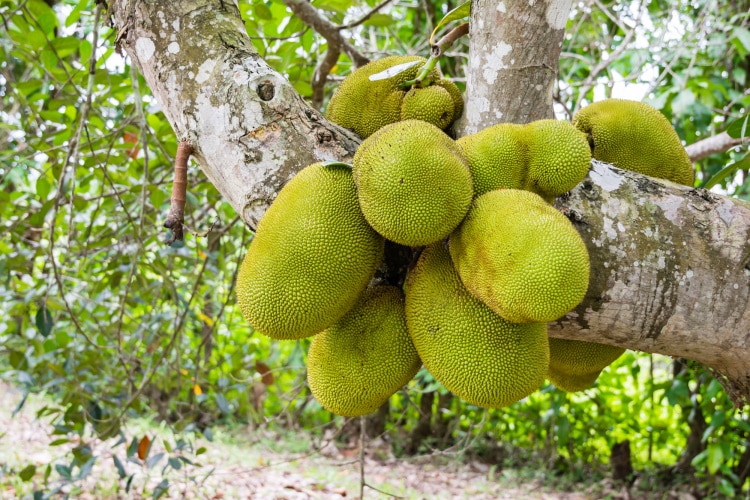
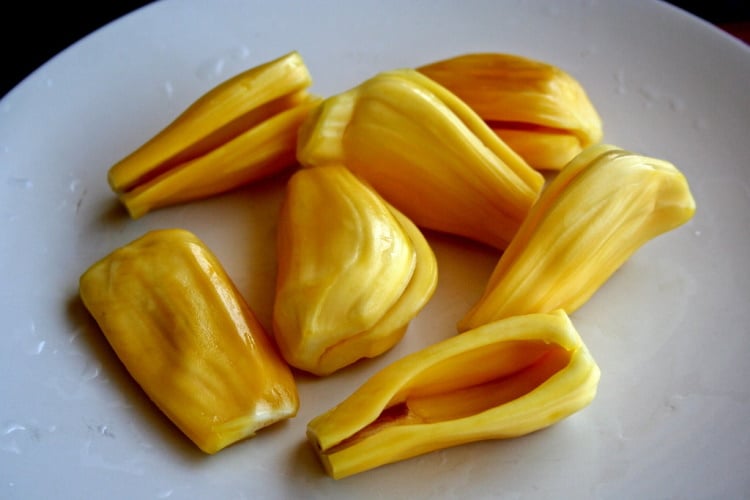
The external appearance of this highly-exotic Thai fruit may be somewhat misleading at first. At around the size of a watermelon and fairly heavy, the jackfruit is one of the biggest fruits found in Thailand.
Inside the tough outer skin of the fruit is contained a bright yellow, sweet, shiny, almost waxy and slightly chewy texture of flesh that is quite unique and delicious.
Jackfruit season is from around January to May, and this fruit works well in a number of Thai dessert dishes, especially those that utilise the rather filling, sweet sticky rice.
5. The Little Lychee
The lychee is a small fruit that looks kind of exotic from the outside. The small and soft fruit is contained within a red, soft shell that has a rough texture but is easy enough to open with fingernails. The colour of the shell also indicates the ripeness of the fruit.
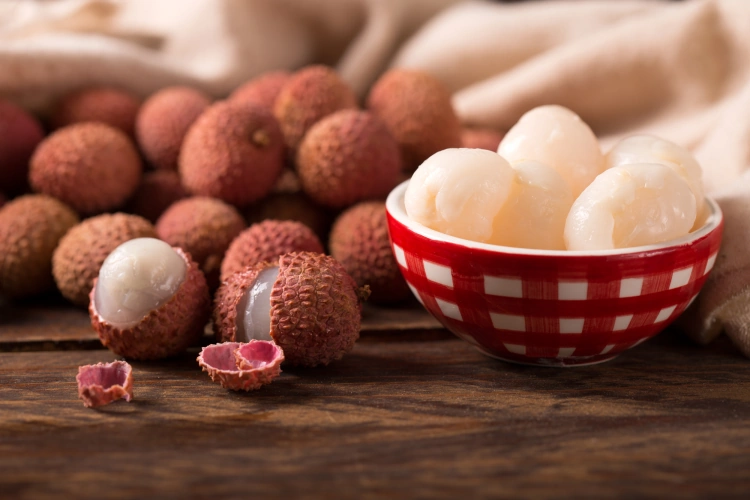
Inside the lychee shell is a whitish, slightly translucent fruit with a soft texture. There is a single stone or seed in the middle which should be taken out.
Like many of the exotic, cooling tropical fruits of Thailand the lychee is found throughout the SE Asian region and is usually in season somewhere between July and October, although you’ll always find canned products in convenience stores.
6. The Alien Rambutan
Part of the same family as the Lychee, the rambutan is another small Thai fruit with a slightly bizarre appearance. It doesn’t look unlike a red, alien, hairy ball in fact. Actually though it’s not hair on the exterior as such, it’s more of a spiny skin that’s slightly pliable.
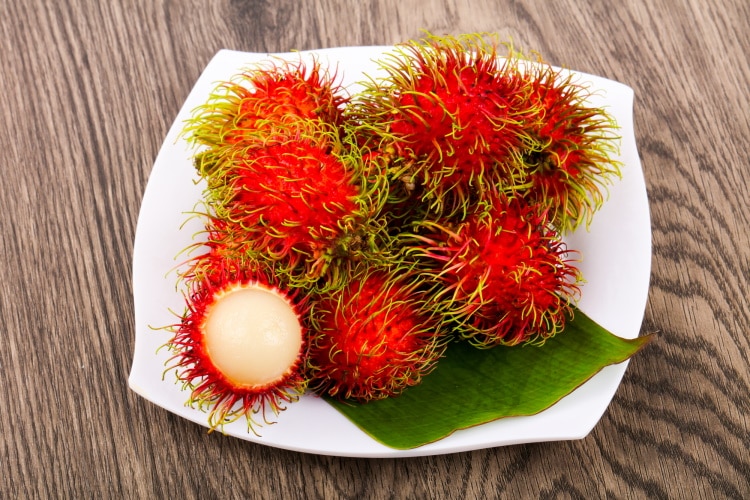
Inside the spiny alien ball is a delightfully sweet, almost grape-like, whitish flesh. The texture and taste is not entirely dissimilar to that of the lychee either—no real surprise when you learn that the two fruits are part of the same family (along with yet another similar Thai fruit not featured here known as the Longan).
The rambutan is a fruit that again makes it into many popular Thai dessert dishes. That said, the small, hard-skinned variety of Thai fruits such as lychees and rambutan are not so much sold with street vendors, who usually specialise in larger, cut fruit.
So they are more often than not sold by the kilo (at around 40 baht), and there are many open-backed vans driving around selling such fruits from the back with the help of a loudspeaker announcing their wares. After getting more familiar with the Thai with the help of our list, you’ll soon be ordering rambutan and lychee by the kilo on your next trip!
7. The Distinctive Snake Fruit (Salacca)
The Salacca, also known as ‘Snake Fruit’, is another small fruit with a rough, slightly spiny skin or shell considered not dissimilar to the skin of a snake. It may be considered similar in some ways to the lychee or rambutan in terms of size and exterior colour.
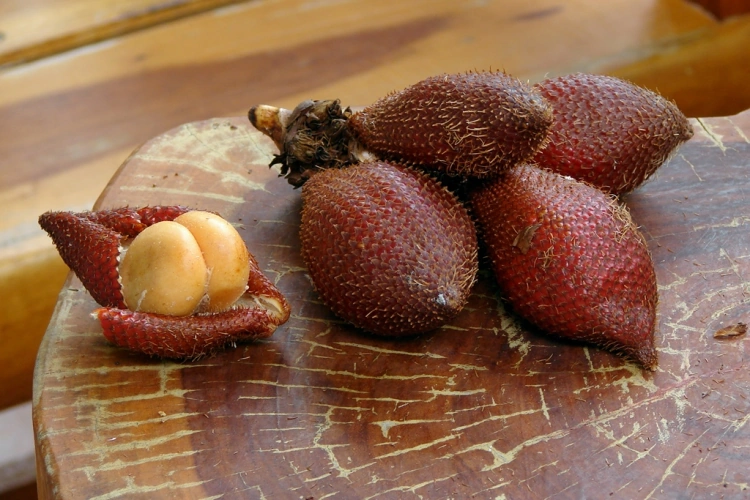
That aside though, the snake fruit really has its own quite unique and distinctive aroma and flavour. It could be described as somewhat on the sweet, citrusy and crunchy side.
The snake fruit is seasonal and typically most common between June and August. Like the other small varieties this exotic Thai fruit is found in Thai desserts, specifically one made with syrup and ice cubes known as Sala Loi Kaew.
8. Sweet and Juicy Papaya
Many Thais are likely to associate the word ‘papaya’ with the unripe variety of the fruit used in the infamously spicy northeastern dish ‘som tum’. That’s not what we are dealing with here though. In fact, the fully-ripened, sweet and juicy orange papaya is quite far-removed from the som tum variety.
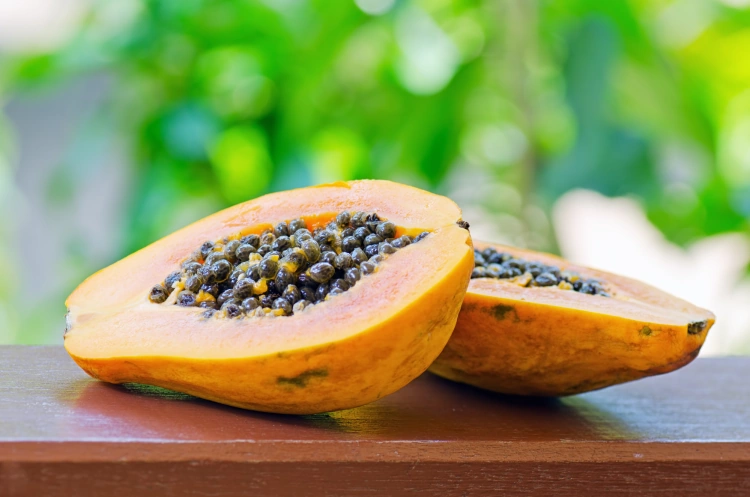
The fully-ripe papaya is soft and orange and delightfully sweet. As it is one of the Thai fruits that tends to be on the larger side, it is cut and sold on the street vendor carts as well as in markets and supermarkets (either whole or cut and packaged).
Papaya is filling, sweet, and cooling—just the ticket for a healthy snack on a hot & humid afternoon. This versatile fruit is available year-round, it can be eaten either ripe or unripe, and it is also used in various curries such as the soup-like curry ‘Gaeng Som’.
9. The ‘Queen of Fruits’—Mangosteen
Often referred to locally as ‘the Queen of Fruits,’ this regal-looking fruit (with its ‘crown’ on the top) packs a rather unique, distinctive, sweet, and tangy taste.

The mangosteen is an exotic fruit not specifically unique to Thailand in that it is common to the expanse of SE Asia. Its skin is a dark purple colour, and the depth of the colour of the skin is again an indicator towards the ripeness of the fruit.
Inside the skin the fruit is composed of segments containing white, soft, and juicy fruit with a hint of creaminess. They also contain seeds which are hard and not edible.
The mangosteen season comes just on the tail end of the Thai summer around the beginning of June. This relatively small fruit tends to be another sold mainly at markets or from the backs of the mobile fruit-selling vans who deal in kilos.
10. The ‘Hand-Grenade’ Custard Apple (Noi-Na)
The custard apple has a somewhat bizarre and again exotic-looking appearance in terms of its light grey-green exterior This skin is knobbly and coarse in texture, and the fruit doesn’t look unlike a grenade in terms of size and shape.
As its name may suggest, the fruit is sweet and somewhere between an apple and custard. This is true in terms of texture and taste, and again this fruit contains small, black, inedible seeds at the centre. The custard apple is a delightfully-different and unique sweet treat from the tropics.
Most of this fruit is sold out of markets, supermarkets, or the trusty old mobile fruit-selling van which does the rounds when fresh stock is in.
11. The Pear-Shaped Rose Apple (Chompoo)
The rose apple could be mistaken for a pear in terms of shape, although the skin is closer to an apple in that it is a dark red or green and a touch waxy.
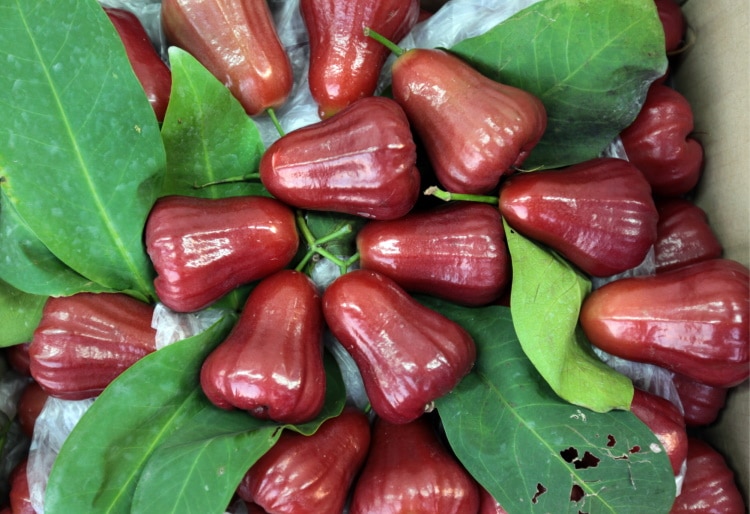
When you cut the rose apple open, you’ll find the core pretty much hollow—no seeds this time, just a touch of fluffy-type matter that should be scraped out. So you can basically eat the whole thing.
The texture and taste inside the skin is somewhere akin to a cross between a watermelon and an apple. The most common variety of rose apple in Thailand tends to be the one with light green skin, which is available almost year round. It is in fact the seasonal varieties that cause the variations in colour from apple red to a much darker red.
12. The Giant Citrus—Pomelo
The pomelo is a very large citrus fruit, as its scientific name Citrus Grandis suggests perfectly. The fruit can reach the size of a football and has a very thick skin.
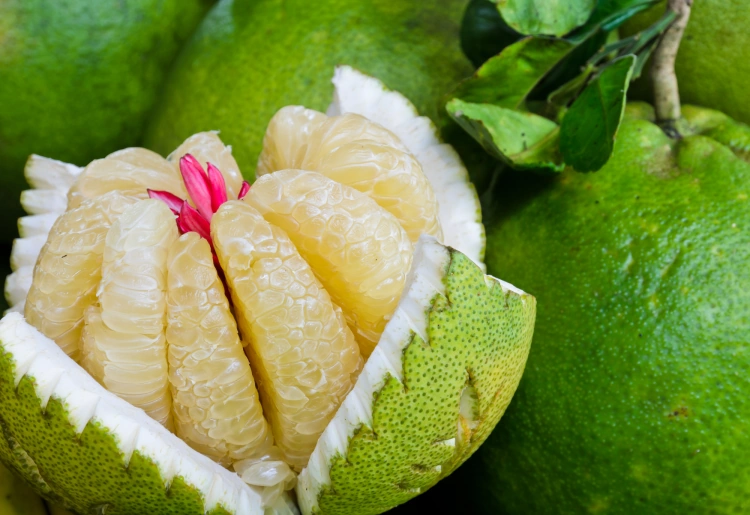
Inside the tough exterior is segmented flesh typical of other citrus fruits, particularly the larger ones. The taste is very similar to a grapefruit, although some would say without being overly-sour or bitter.
This huge, grapefruit-style fruit is actually very easy to eat due to the flavour and it is somewhat less messy than you might expect for a citrus fruit. This has something to do with the fact that the membranes and skin containing the juice is thicker than your average citrus and is thus easier to handle.
Pomelo is generally available all year round, but it comes into something of a high season around October-time.

Mark Philip is a writer and lifestyle enthusiast from the Midlands in the U.K. With a background in martial arts and fitness, Mark upped sticks and headed out to Bangkok to delve a bit deeper into the art of Thai Boxing way back in the 2000s, starting to write initially to fund his daily training and escape the rigours of ESL teaching. Since then Mark has authored e-books, articles, and blogs across a wide range of topics for commercial, educational, factual, health & fitness, lifestyle, wellness, and leisure-based purposes.







